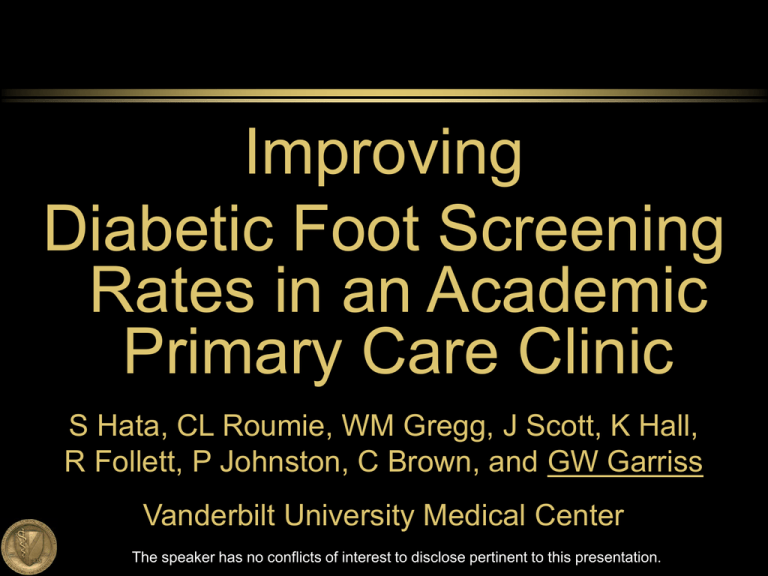Recommendations for Preventive Pediatric Health Care
advertisement

Improving Diabetic Foot Screening Rates in an Academic Primary Care Clinic S Hata, CL Roumie, WM Gregg, J Scott, K Hall, R Follett, P Johnston, C Brown, and GW Garriss Vanderbilt University Medical Center The speaker has no conflicts of interest to disclose pertinent to this presentation. Context Academic Chronic Care Collaborative sponsored by the AAMC Promoted health care innovations in academic health centers 22 AHC participated in improving chronic illness care Vanderbilt addressed diabetes care Screening Diabetic Foot Exam The American Diabetes Association recommends a yearly diabetic foot exam. Early detection and intervention prevent morbidity and amputations. Locally, our adherence to this guideline has been suboptimal. What are you trying to accomplish? Aims Measure our local data on documented foot exams Improve the proportion of documented 4 element diabetic foot exams (DFE) to greater than 90%, through use of PDSA cycles to implement evidence-based guidelines Hypothesis Percentage of completed/documented DFEs would be improved by use of PDSA cycles to institute small tests of change in a year How will you know a change is an improvement? Process Measures Percent of foot exams documented with each method Templated note • Team DFE • Both • Other (free text writing in a note) • Outcome Measure Proportion of patients with diabetes who have 4 element DFE documented within the past 12 months Design and Setting Study Design: Observational Study with multiple Plan-Do-Study-Act cycles Setting: Adult Primary Care Clinic Vanderbilt University Medical Center, Nashville, TN IRB approval obtained Study Timeline Intervention #1 - Provider Education Intervention #2 - Posters Intervention #3 - Note template Intervention #5- Team approach Registry created June 2004 Study completed July 2005 October 2005 June 2006 Intervention #4 - Provider Feedback (quarterly) Methods - Population Inclusion • • • Criteria Registry created, June 2004 Search problem lists for “diabetes” or “DM” ICD-9 CM = 250.x within the last 2 years Patients < 18 y.o. Study population • • were excluded 338 patients with diabetes (July 2005) Registry updated (April 2006) to 387 patients What changes can you make? Intervention #1 – Provider Education July 2005 Met with primary care providers Encouraged cooperation by sharing data regarding foot exam rates Discussed the goals of the Diabetic Foot Exam Project Standardized DFE method for resident and faculty providers Complete Diabetic Foot Exam Based on ABIM’s PIM for diabetes Four elements: • • • • Visual inspection Pulses Sensation 10 g monofilament Singh N, Armstong DG, and Lipsky BA. Preventing Foot Ulcers in Patients with Diabetes. JAMA. 2005; 293:217-28. Intervention #2 – Poster Began July 2005 Intervention #3 – Note Template Introduced July 2005 Included ADA guidelines for: Glycemic control • BP control • LDL goals • Annual DFE • Physical exam in template included 4 element DFE Intervention #4 - Provider Feedback Began July 2005 and continued quarterly Practice report of patients with diabetes Report included each patient’s most recent: • • • • A1c BP LDL DFE Intervention #5- Team Approach Patient presents to primary care Nurse performs DFE Tech asks “Do you have diabetes?” DFE completed & documented in medical record Prompts pt to remove shoes Alerts Nurse pt with DM Nurse notifies doctor pt is ready for visit Intervention began October 2005 Analysis Outcome extracted through manual and electronic chart review Run Chart using a rolling 12 month period and updated monthly Results- Patient characteristics Characteristic Population=338 patients N (%) Age - years, mean ± SD 51.9 ± 14.3 Female sex 218 (64.5) A1C <7% 118 (35) LDL <100 (mg/dL) 176 (52) BP <130/80 111 (33) ACEi/ARB use 270 (80) Results- Provider characteristics Characteristic N=38 providers (%) Age (mean ± SD) 31 ± 5 Sex 19 (50) Attending MD 9 (23.7) Resident MD 29 (76.3) Clinics per month, attending mean (range) 12.5 (4-16) Clinics per month, resident mean (range) 3 (2.6-3.6) Pts per provider, mean (range) 9.9 (1 - 50) 60 40 30 20 10 + pl at e th er O FE D Te m Te am Te Te am 0 ot e N July/August 2005 December 2005 June 2006 50 m pl at e percent of total foot exams Results – Method to Complete/Document DFE Absolute increase of 65% 100 82% 80 60 40 17% 20 0 with E percent of patients with documented DFE Results 0 1 100 2 3 4 5 6 7 8 9 10 11 12 n = 338 Diabetic Foot Exam Run Chart Registry updated/ expanded from n = 338 to 387 Goal (April 2006) Team DFE started in other Suites O ct De c Fe b Au g Ju n Ap r (Jan 2006) O ct De c Fe b Baseline 100 90 80 70 60 50 40 30 20 10 0 Au g Documented “Full” Diabetic Foot Exam Percent of Patients with Data From ACCC Cohort and Controls * Controls = 350 Randomly Selected Non-ACCC Cohort Patients ACCC Cohort *Controls Limitations One academic primary care clinic site Small number of patients and providers Multiple interventions employed simultaneously Note templates may introduce some inaccuracy Lessons Learned • Weak links in our system • • • • Lost monofilaments Forgetful, busy providers Resistance to change A team approach can fix problems • • • Redundancy to prevent missed opportunities Time saving for providers “Doctor-proofed” Summary and Implications Multi-factorial interventions resulted in an absolute increase of 65% in annual DFE rate Increased teamwork among physicians, nurses, techs Improved quality of care for patients with diabetes Plan to expand these interventions to all primary care clinics at Vanderbilt Acknowledgements Susan Hata, MD Christianne Roumie, MD MPH William Gregg, MD, MPH Julie Scott, RN Kara Hall, RN Robert Follett, BS Phil Johnston, Pharm D Charlotte Brown, BS Excerpt of Note Template (Intervention #3) “We are what we repeatedly do. Excellence, then, is not an act, but a habit.” - Aristotle


